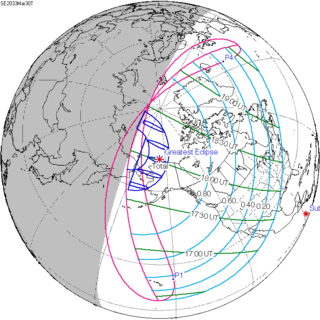| Solar eclipse of March 30, 2033 | |
|---|---|
| Type of eclipse | |
| Nature | Total |
| Gamma | 0.9778 |
| Magnitude | 1.0462 |
| Maximum eclipse | |
| Duration | 157 s (2 min 37 s) |
| Coordinates | 71°18′N 155°48′W / 71.3°N 155.8°W |
| Max. width of band | 781 km (485 mi) |
| Times (UTC) | |
| Greatest eclipse | 18:02:36 |
| References | |
| Saros | 120 (62 of 71) |
| Catalog # (SE5000) | 9581 |
A total solar eclipse will occur at the Moon's descending node of orbit on Wednesday, March 30, 2033,[1] with a magnitude of 1.0462. A solar eclipse occurs when the Moon passes between Earth and the Sun, thereby totally or partly obscuring the image of the Sun for a viewer on Earth. A total solar eclipse occurs when the Moon's apparent diameter is larger than the Sun's, blocking all direct sunlight, turning day into darkness. Totality occurs in a narrow path across Earth's surface, with the partial solar eclipse visible over a surrounding region thousands of kilometres wide. Occurring about 11 hours after perigee (on March 30, 2033, at 7:10 UTC), the Moon's apparent diameter will be larger.[2]
Totality will be visible from parts of the Russian Far East and Alaska, including in the cities of Nome, Alaska and Utqiaġvik, Alaska in the mid-morning hours. A partial eclipse will be visible for parts of eastern Russia, Hawaii, North America, Greenland, and Iceland. This will be the last of 55 umbral eclipses in Solar Saros 120.
- ^ "March 30, 2033 Total Solar Eclipse". timeanddate. Retrieved 14 August 2024.
- ^ "Moon Distances for London, United Kingdom, England". timeanddate. Retrieved 14 August 2024.
